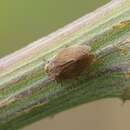fi
nimet breadcrumb-navigoinnissa


Die Gelbe Käferzikade (Agalmatium flavescens) ist eine Zikadenart innerhalb der Familie der Käferzikaden (Issidae) in der Unterordnung der Spitzkopfzikaden (Fulgoromorpha).
Die Zikadenart erreicht eine Körperlänge von 4,5–5 mm bei den Männchen sowie 5,3–6 mm bei den Weibchen. Die Zikaden besitzen eine kompakte Gestalt mit einem kurzen, breiten Kopf. Die Färbung der Zikaden ist sehr variabel. Es gibt sandfarbene helle Exemplare, aber auch hellbraune mit dunklen großflächigen Flecken. Der äußere Rand der Vorderflügel ist jedoch immer gelblich gefärbt.
Das erste hintere Tarsenglied (Metatarsomere) weist am apikalen Ende zwischen den beiden Seitendorne nur zwei kleine Dorne auf.[1] Der obere Teil der Stirnregion (Frons) weist keine horizontalen Querkiele auf. Der Analausgang der Männchen weist am hinteren Ende zwei ausgeprägte Loben auf.
Die Gelbe Käferzikade ist in der westlichen Paläarktis verbreitet. Ihr Verbreitungsschwerpunkt liegt im Mittelmeerraum. Ihr Vorkommen erstreckt sich von der Iberischen Halbinsel über Südosteuropa und Kleinasien bis in den Kaukasus und den Nahen Osten.[1] In Nordafrika sowie auf den Kanarischen Inseln ist die Art ebenfalls vertreten.[2] Im Norden reicht das Vorkommen bis in das südliche Mitteleuropa.[1]
Die Gelbe Käferzikade ist eine polyphage Zikadenart. Zu ihren Wirtspflanzen zählt die Echte Feige (Ficus carica), die Luzerne (Medicago sativa), der Olivenbaum (Olea europaea), Kiefern (Pinus), Pappeln (Populus), der Mandelbaum (Prunus dulcis) sowie Tamarisken (Tamarix). Man beobachtet die Imagines hauptsächlich in den Monaten Juli bis September. Man findet sie gewöhnlich an Sträuchern oder an Baumstämmen. Das Weibchen legt ihre Eier in einer Oothek an den Wirtspflanzen ab. Die Nymphen schlüpfen im Frühjahr und durchlaufen mehrere Häutungen.
Mit Camposnotus aethiops, einer Rossameisen-Art, gibt es offenbar eine Trophobiose. Die Ameisen animieren die Zikaden zur Sekretion von Honigtau.[3]
In der Literatur finden sich folgende Synonyme:[1][2]
Die Gelbe Käferzikade (Agalmatium flavescens) ist eine Zikadenart innerhalb der Familie der Käferzikaden (Issidae) in der Unterordnung der Spitzkopfzikaden (Fulgoromorpha).
Agalmatium flavescens is a species of planthopper belonging to the family Issidae, subfamily Issinae.[2]
This species is present in Albania, Armenia, Austria, Bulgaria, France, Georgia, Greece, Hungary, Italy, Moldova, Montenegro, Portugal, Romania, Russia, Serbia, Slovenia, Spain and Turkey.[3][4]
Agalmatium flavescens can reach a body length of approximately 4.5–5 millimetres (0.18–0.20 in) in males, of 5.3–6 millimetres (0.21–0.24 in) in females.[5] These planthoppers are characterized by a rather variable coloration. There are light specimens with a straw coloration, and light brownish specimens, with dark brown markings. The border of the forewings is always yellowish. Apical tube in males shows apically two distinct lobes.[5]
Like all species of the genus, the first segment of hind legs (metatarsomere) has only two intermediate spines apically. In the upper part of the forehead the horizontal transverse carinae are missing. The shape of the body is compact, the head is short and wide. Wings are rather developed, elytra are quite short. Legs are short and strong.[3]
This species is bivoltine, with two generations per year. Adults can be found from May to July and from Septembre to November.[6]
Recorded food plants are Ficus carica, Medicago sativa, Olea europea, Pinus species, Populus species, Prunus amygdalus and Tamarix species.[7]
It has been reported a trophobiotic association between this planthopper species and a species of ant (Camponotus aethiops), with honeydew drops directly collected by ants from the anal openings of these issids.[8]
Agalmatium flavescens is a species of planthopper belonging to the family Issidae, subfamily Issinae.